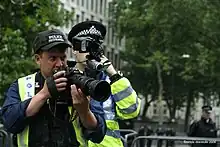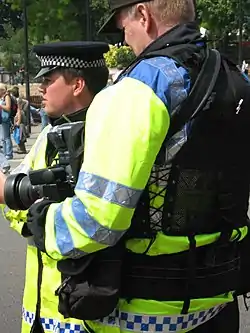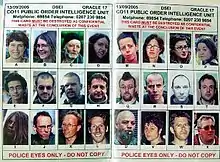


Forward Intelligence Teams (FITs) are two or more police officers who are deployed by UK police forces to gather intelligence on the ground[1] and in some circumstances, to disrupt activists and deter anti-social behaviour. They use cameras, camcorders and audio recorders to conduct overt surveillance of the public. An unsuccessful legal challenge has been made against their use of overt surveillance, but in 2009 the Court of Appeal ruled that they must justify retention of photographs on a case-by-case basis. Any retained information is recorded on the Crimint database.
Political activists have criticised FITs and said that they feel the aim of FIT deployment during protests is to prevent legal protests. Journalists have also complained that FITs attempt to stop them photographing protests and that they conduct surveillance of journalists. A campaign group, Fitwatch, formed in 2007 that aim to obstruct FITs and conduct sousveillance on the officers. Two members of the group were arrested at the 2008 Climate Camp on obstruction charges. A similar police surveillance unit, the Video Intelligence Unit is operated by Greater Manchester Police. In June 2010, the Home Office announced it would review the use of FITs during public order policing.
History and purpose
FITs were first formed in the early 1990s,[2] as part of the Public Order Intelligence Unit (CO11), a section of the Public Order Branch of the Metropolitan Police. They initially targeted football fans, hunt saboteurs and political protesters (since at least 1996),[3] using cameras, camcorders and audio recorders to conduct overt surveillance of the public.[4] The police officers wear full uniform, and are intended to be a highly visible presence. Their uniform is sometimes different from normal police officers in that the upper half of their yellow fluorescent jackets is blue. Civilian photographers are also employed by the police to work alongside FITs.[5] According to Scotland Yard, the aim of FIT teams at protests is to record evidence of protesters in case disorder occurs later on at a protest.[6]
More recently the teams' purpose has been extended to routine police work on low-level crime and anti-social behaviour and police forces throughout the UK now have their own FITs.[7] Despite the implication in their name that their function is to merely gather intelligence, they are also intended to have a deterrent effect.[4][8] This approach has been reported to work in reducing reports of anti-social behaviour at times when FITs are deployed in specific neighbourhoods.[9] Jacqui Smith, then Home Secretary praised Operation Leopard that used FITs to target youths, in Laindon, Essex stating:[10]
"Operation Leopard is exactly the sort of intensive policing that can bring persistent offenders to their senses... Relentless filming of them and their associates throughout the day and night"
Linda Catt, an activist, has suggested that their tactics are "designed to intimidate people and prevent lawful dissent".[11] This view is echoed by a police debriefing of their operations at the 2008 Camp for Climate Action which praised FITs at the event for disrupting activists.[12]
In June 2010, the Home Office announced it would review the use of FITs during public order policing. The move was influenced by the discovery that information collected by FITs, included that which was unrelated to suspected crimes, for example recording who made speeches at demonstrations.[13]
In October 2010, FIT officers in plain clothes were spotted by a press photographer at a protest against companies avoiding tax, despite Commander Bob Broadhurst telling a parliamentary committee in May 2009, that only uniformed officers distinguishable by their blue and yellow jackets were involved in gathering intelligence at protests. The Metropolitan Police told The Guardian that it was necessary to deploy plain-clothed officers to "gather information to provide us with a relevant and up-to-date intelligence picture of what to expect". It was the first time that FITs are known to have been deployed in plain clothes.[14]
Legal issues
Liberty brought a judicial review of the overt surveillance practices in May 2008, which was decided in favour of the police,[15][16] however the police were asked to clarify their evidence[17] to the Court of Appeal, following an investigation by The Guardian newspaper.[18][19]
In May 2009, the Court of Appeal ruled that photographs collected by FITs of people who have not committed a criminal offence can no longer be kept. The ruling was made after Andrew Wood, an arms trade activist, was photographed after challenging the management of Reed Elsevier at their AGM over them organising arms trade exhibitions. Wood argued that police had harassed him and infringed his right to privacy by photographing him. Lord Collins of Mapesbury said that the police presence had a "chilling effect" on people who were protesting lawfully. FITs have not been banned but they must now justify the retention of photographs on a case-by-case basis.[20] As a result of the ruling the Metropolitan Police's public order unit, CO11 was forced to delete 40% of the photos of protesters that it held.[21]
In a report about the policing of the 2009 G-20 London summit protests, Denis O'Connor, the chief inspector of constabulary, stated that the routine use of FITs at protests "raises fundamental privacy issues and should be reviewed". He also said that there was "confusion" over the role of FITs and advised that the Home Office should issue guidance over the legality of the surveillance of protesters and the retention of images.[21]
Information processing

The information that FITs collect is stored on the Crimint database, which is used daily by police officers to catalogue criminal intelligence. People are listed by name allowing police to determine which events individuals have attended.[18] Photographs obtained by FITs are used to produce "spotter cards" consisting of people's photographs which allows officers to identify people at future events that they attend.[22] For £10, people are able to obtain a list of protests that they have attended from the data held on Crimint under laws in the Data Protection Act 1998.[23]
Academic response
A 2006 report, The Economics of Mass Surveillance calculated that the use of FITs at mass gatherings involves gathering intelligence on roughly 1,200 people to record the actions of one person. The report also noted that most of the people on "spotter cards", used by the police photographers, were those involved in the organisation of protests and that FITs also attend meetings where demonstrations are organised.[24]
Criticism
Fitwatch (formed in early 2007)[25] campaign against FITs by actively obstructing their operations, and by passively opposing their operations by photographing units (a form of sousveillance).[26]
In June 2009,The Guardian released video evidence recorded by a FIT at the 2008 Climate Camp of alleged police brutality against two female members of Fitwatch. The women had asked police officers to reveal their shoulder numbers, as at least four officers had not displayed them. The women attempted to photograph the police officers for evidence, but were forced to the ground, restrained with handcuffs, and had their legs bound with straps.[27] They were then placed in restraint positions, arrested, charged and held in custody for four days, including three days in HMP Bronzefield, before they were released on bail.[28] The police later retracted all the charges against the women. The women lodged a complaint with the IPCC over the incident.[27] The journalist George Monbiot commented on this case, saying that "the police are turning activism into a crime" and that "the FITs' methods appear to have been lifted from a Stasi training manual". He claimed that "anybody who is politically active is filmed, identified, monitored, logged, and cross-checked".[29] A police debrief into the operation at Kingsnorth praised the deployment of FITs saying that they were "highly effective and gained good intelligence and disruption".[30]
Three members of Fitwatch were convicted for obstructing FIT officers in June 2008 as they attempted to photograph those attending a No Borders meeting in London. In July 2010 the Inner London Crown Court overturned the men's convictions, with the judge stating that the protesters' human rights may have been violated by the FIT officers.[6]
On 15 November 2010, the hosts of the Fitwatch blog were asked by the Police National E-Crime Unit to take down the website due to it "being used to undertake criminal activities". The request came after a post on the blog after the 2010 student protest in London, which advised students of actions they should take if they were concerned that they were photographed at the demonstration, such as cutting their hair and disposing of clothing they were wearing. Emily Apple, one of the founders of the site told The Guardian, "Nothing in that post [giving guidance to student protesters] has not been said before on our blog or on other sites".[31] On 17 November 2010, the Fitwatch website returned, hosted on a web server outside of the UK.[32]
The National Union of Journalists (NUJ) has criticised FITs for their surveillance and sometimes violent harassment of working journalists. Marc Vallée, who was hospitalised by police after documenting a protest,[33] has said that the teams limit freedom of the press and called on the Home Office to confirm that the police had no right to restrict the work of photojournalists. Bob Broadhurst, who is in charge of public order policing at the Metropolitan Police, said in a statement to the NUJ in 2008 that journalists, "on the production of a valid form of accreditation will be able to continue with their work".[34] The NUJ are to make a formal complaint to the Information Commissioner due to the Metropolitan Police failing to provide details on the surveillance of journalists under the Freedom of Information Act. Bob Broadhurst told photographers at an NUJ conference that he had no faith in the National Press Card (a form of press pass) despite journalists needing to prove that they are bona-fide newsgatherers to an independent authority before they are issued.[35]
The BBC TV series Panorama produced an episode entitled "What ever happened to people power?" in July 2009 which discussed the use of FITs in targeting activists and journalists.[36]
Similar police units
Greater Manchester Police operate a Video Intelligence Unit, whose plainclothes officers confront and video certain freed prisoners as they leave prison after serving their sentences. They also record footage of people involved in anti-social behaviour on the streets. The aim is to give other police officers up to date information on the appearance of people who have broken the law. Video footage thus collected is constantly replayed on TV screens in rooms where officers complete their paperwork. Footage that they have recorded has also been uploaded onto YouTube in an attempt to catch people they believe have reoffended.[37][38] This has resulted in several offenders being sent back to prison after breaching licence conditions. Since the unit was launched in 2006 more than 900 people have been filmed by the unit. Not all of these people are suspects in crime however, people can be filmed if they are thought to associate with prolific offenders or if they have been stopped in an area of high crime under suspicious circumstances. Kieran Walsh, a civil liberties lawyer, said the unit's work "could have implications" for the force under Article 8 of the European Convention on Human Rights - the right to privacy. He believes that filming must be a "proportionate and reasonable" response to a crime and that this does not appear to be the case as people are being targeted over what they might do in the future. It is uncertain as to how long data collected by the unit is to be kept but GMP currently anticipate it will be stored for five years.[39]
See also
- Police intelligence
- COINTELPRO – a project by the FBI which investigated and disrupted dissident political organizations within the United States
References
- ↑ http://www.nationalarchives.gov.uk/ERORecords/HO/421/2/hmic/disord3.pdf Home Office Chapter 3 Responding to disorder archived
- ↑ Provost, Claire (3 May 2008). "Is this what a police state looks like?". New Statesman. Retrieved 9 June 2009.
- ↑ George Monbiot, "Defective Inspectors (archived)". 29 August 1996, The Guardian Archived
- 1 2 "FIT Policing is Here to Stay" (PDF). The Law. Essex Police. 25 May 2006. Archived from the original on 20 June 2006. Retrieved 6 September 2006.
{{cite web}}: CS1 maint: bot: original URL status unknown (link) - ↑ Salusbury, Matt (19 October 2003). "LONDON LIVES: The police paparazzi". The Independent on Sunday. Archived from the original on 26 October 2012. Retrieved 9 May 2009.
- 1 2 Protesters' rights were violated by Met surveillance Mark Blunden London Evening Standard 28.07.10 archived link
- ↑ Lewis, Paul (30 May 2008). "Harass a hoodie: how Essex police take surveillance to the streets | UK news". The Guardian. London. Retrieved 9 June 2009.
- ↑ "Practice Advice on Police Use of Digital Images" (PDF). NPIA. 17 December 2007. Retrieved 7 October 2011.
- ↑ Crackdown sees drop in antisocial behaviour Daily Gazette 26 August 2009 archive link
- ↑ 5.00 Operation LeopardThe Guardian Paul Lewis and Simon Green 30 May 2008
- ↑ Catt, Linda (13 March 2009). "Police tactics seek to 'intimidate people and prevent lawful dissent'". The Guardian. London. Retrieved 9 May 2009.
- ↑ P21 Operation Oasis Debrief Kent Police 9 October 2008 archive link
- ↑ Peel, Michael; James Boxell; Marc Vallée (30 June 2010). "Police use of protest photos will face review". The Financial Times. Retrieved 16 July 2010.
- ↑ Paul Lewis; Adam Gabbatt; Matthew Taylor; Simon Jeffery (3 December 2010). "UK Uncut protesters spied upon by undercover police". The Guardian. London. Retrieved 3 December 2010.
- ↑ "Retaining photographs lawful". The Times. London. 13 June 2008. Retrieved 10 March 2009.
Taking and retaining photographs of someone engaged in a political protest or demonstration was not unlawful and did not infringe his human rights.
- ↑ Justice McCombe (22 May 2008). "Wood v Commissioner of Police for the Metropolis [2008] EWHC 1105 (Admin)". England and Wales High Court (Administrative Court) Decisions. Retrieved 10 March 2009.
- ↑ Paul Lewis (10 March 2009). "We were wrong to film journalists covering protest, say Kent police". The Guardian. London. Retrieved 10 March 2009.
Metropolitan police have been asked to clarify evidence they submitted to the court of appeal about the use of the tactic
- 1 2 Paul Lewis; Marc Vallée (7 March 2009). "Revealed: police databank on thousands of protesters". The Guardian. London. pp. 1–2. Retrieved 10 March 2009.
Police are targeting thousands of political campaigners in surveillance operations and storing their details on a database
- ↑ Paul Lewis; Marc Vallée (7 March 2009). "Caught on film and stored on database: how police keep tabs on activists". The Guardian. London. pp. 14–15. Retrieved 10 March 2009.
Police footage obtained by the Guardian has revealed the crude monitoring methods
- ↑ Casciani, Dominic (21 May 2009). "Court curtails Met surveillance". BBC News. Retrieved 21 May 2009.
- 1 2 Lewis, Paul; Sandra Laville (25 November 2009). "'Aggressive' policing of protests condemned in post-G20 inquiry". The Guardian. London. Retrieved 25 November 2009.
- 1 2 "Spotter cards: What they look like and how they work". The Guardian. London. 25 October 2009. Retrieved 26 October 2009.
- ↑ Salusbury, Matt (11 June 2009). "Get yourself a record". New Statesman. Retrieved 2 July 2009.
- ↑ Danezis, George; Bettina Wittnebe (2006). "The Economics of Mass Surveillance" (PDF). The Fifth Workshop on the Economics of Information Security (WEIS 2006). Archived (PDF) from the original on 16 November 2010. Retrieved 30 May 2009.
{{cite journal}}: Cite journal requires|journal=(help) - ↑ Lewis, Paul; Marc Vallée (21 June 2009). "Fit Watch: watching the watchers". The Guardian. London. Retrieved 2 July 2009.
- ↑ Rohrer, Finlo (21 April 2009). "Magazine When all video all Tuesday, 21 April 2009". BBC News. Retrieved 9 June 2009.
- 1 2 Lewis, Paul (23 June 2009). "Surveillance protesters bundled to ground by police". The Guardian. London. Retrieved 23 June 2009.
- ↑ Lewis, Paul; Marc Vallée (21 June 2009). "Fit Watch campaigners describe how they were arrested and bundled to the ground". The Guardian. London. Retrieved 9 July 2009.
- ↑ Monbiot, George (22 June 2009). "Police are turning activism into a crime". The Guardian. London. Retrieved 2 July 2009.
- ↑ P43 Operation Oasis Debrief Archived 2009-08-24 at the Wayback Machine Kent Police 9 October 2008
- ↑ Paul Lewis (16 November 2010). "Met closes down anti-police blog". The Guardian. London. Retrieved 16 November 2010.
- ↑ John Oates (17 November 2010). "Police-baiting website Fitwatch returns". The Register. Retrieved 17 November 2010.
- ↑ "Editorial Photographers UK - Injured photographer wins settlement, costs and apology from Met Police". www.epuk.org. Retrieved 24 October 2021.
- ↑ "NUJ takes protest to Home Office". National Union of Journalists. 28 May 2008. Archived from the original on 6 March 2009. Retrieved 23 May 2009.
{{cite web}}: CS1 maint: bot: original URL status unknown (link) - ↑ "Police contradictions over 'journalists database' spark NUJ complaint". Editorial Photographers UK. 16 June 2009. Retrieved 2 July 2009.
- ↑ What Ever Happened to People Power? BBC Panorama First broadcast 6 Jul 2009 archive link
- ↑ Dowling, Nicola (1 July 2008). "Putting criminals in the picture". Manchester Evening News. Archived from the original on 7 October 2008. Retrieved 8 June 2009.
- ↑ Dowling, Nicola (8 December 2008). "Cops issue video of thug". Manchester Evening News. Archived from the original on 19 December 2009. Retrieved 8 June 2009.
- ↑ "Police have filmed 900 'suspects'". BBC News. 24 July 2009. Retrieved 7 August 2009.
External links
- "WANTED!". 21 December 1995, SchNEWS 54.
- Alan Lodge (Tash), "All about my 'BIG BROTHER'...!!". January 1999.
- Matt Salusbury, "Caught on camera". 15 September 2003, New Statesman
- Fitwatch website